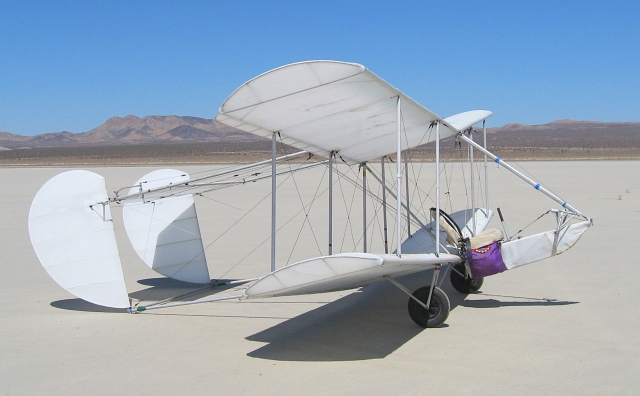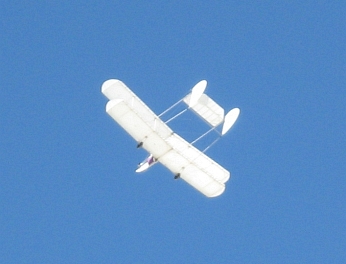Pig Page
by Mike SandlinThe Pig is my latest biplane airchair design....
Last update......
May 5, 2010 (text revision)
Pig Page |
|
The Pig (Primary Instruction Glider) is my latest airchair project, a biplane ultralight sailplane with a two axis control system (rudders & elevator, but no ailerons). Its first high flight was made in September, 2008.

Low time pilots should use a glider that is easy to fly, forgiving, and robust, and which has good crash protection for the pilot. Controls and airframe must look and feel good, to engender the confidence that will reduce pilot stress and allow effective learning. The mechanics of launching and landing should be simple and non-athletic. Things should be happening slowly so the student has time to see mistakes and react to them. The Pig is my current version of this slow/simple/safe aircraft.
The two axis control system has proven to be adequate, simple to use, and fun for recreational flying. Launches have been made by line towing and by rolling off open hillsides.
Here's a video of the Pig doing a rolling launch from a training hill. This is, for now, my brightest vision of entry level flying:
|
|
|
 |
 |
The Pig has a lot of the usual airchair features:
In addition, the Pig has some special features of its own:
Walking the Pig is pretty easy.
The eight main wing struts are mounted on swiveling eye bolts, so that during disassembly the struts can be detached at one end and rotated ninety degrees on the other. This allows each upper wing half to be lowered onto the lower wing half, making a compact stack for car top transport.
Here is an older version of the Pig, floating down the training hill at
Crestline, California, after a rolling launch.
The wing airfoil is a simple utility type that I made up (Pigfoil 3012, 12% thick at 30% chord) with a completely flat bottom. This airfoil is similar to that of some radio controlled trainer gliders, and much like a Piper Cub. From this I expect good low speed flying characteristics and easy construction. This airfoil can also provide a strong and stiff trailing edge which will tolerate rough assembly on irregular terrain (the wing section is assembled with the trailing edge on the ground).
I'm in the Pig, at the beginning of a truck tow, up and rolling. The towline can be seen dipping off to the left, with the aft end attached to the tow hook at the nose of the glider. I'm reaching up to the middle of the nose tube, ready to pull the release handle.
The current empty weight, with parachute, is 147.5 lbs. (This may be a few pounds heavier than my previous airchairs, but with an estimated gross weight of 308 lbs, my 194 square foot wing area gives me a wing loading of 1.6 lbs. per square foot, still well down into the hang glider range, so I'm happy with this.)
I have nothing for sale and no commercial intentions. The Pig1 technical drawings are available for on line viewing or download, see the main menu, Basic Ultralight Glider homepage, "Pig Drawings". There are 81 drawings available in three different file formats. Also see my Airchair Update Page for the latest news.
[END]